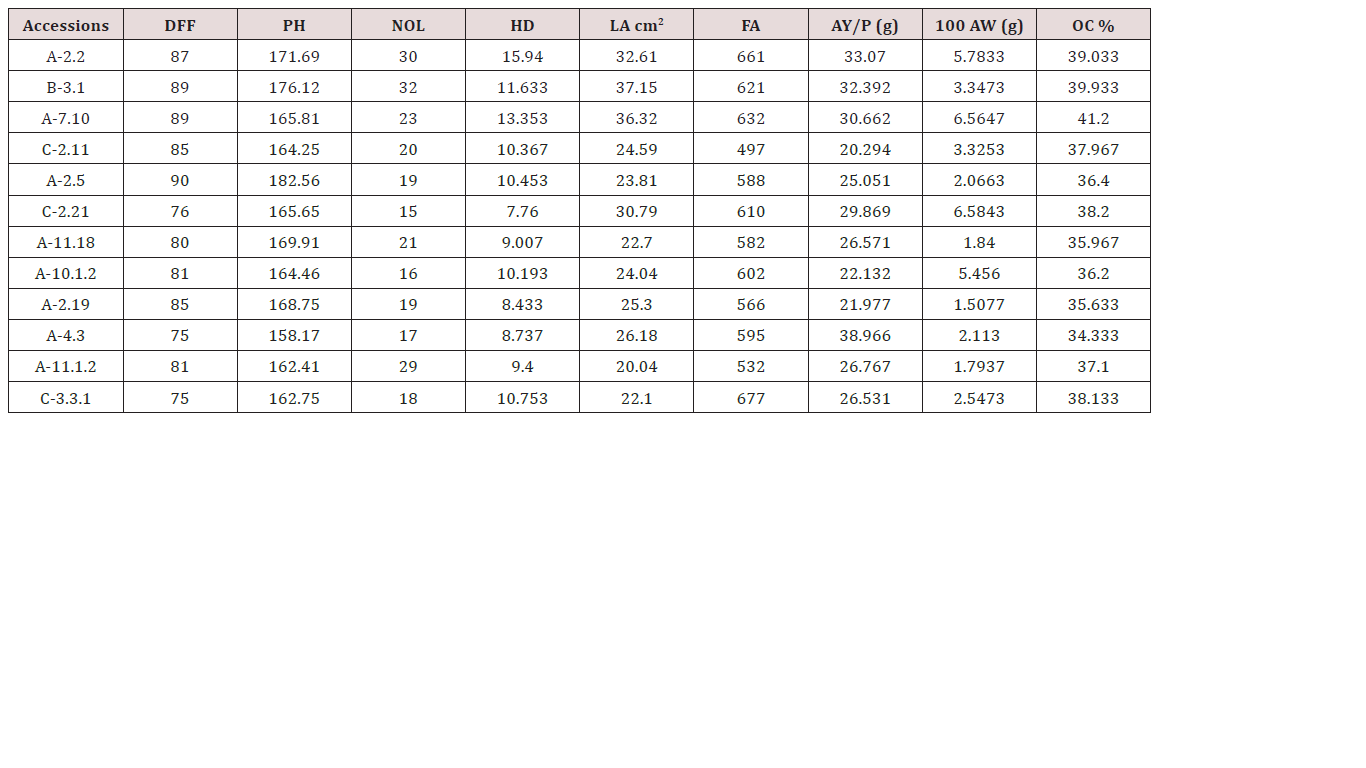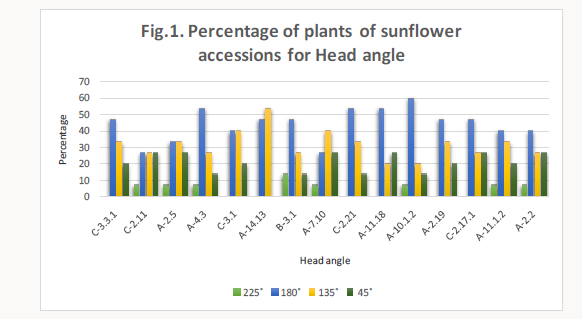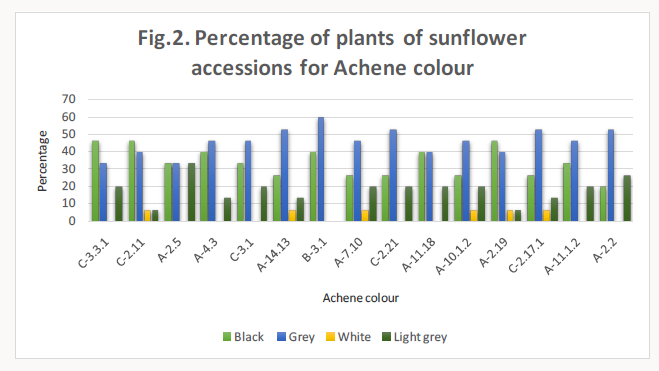
Lupine Publishers Group
Lupine Publishers
Menu
ISSN: 2637-4676
Research Article(ISSN: 2637-4676) 
Genetic Variability Studies for Economically Important Traits in Sunflower (Helianthus Annuus L.) Volume 2 - Issue 2
Maria Ghias1, Farooq Ahmad Khan2, Sajida Habib1, Rizwana Qamar1, Fida Hussain1, Hafiz Saad Bin Mustafa1* and Muhammad Aftab1
- 1Directorate of Oilseeds, Ayub Agricultural Research Institute, Pakistan
- 2Department of Plant Breeding and Genetics, University of Agriculture, Pakistan
Received: April 13, 2018; Published: April 23, 2018
Corresponding author: Hafiz Saad Bin Mustafa, Directorate of Oilseeds, Ayub Agricultural Research Institute, Pakistan
DOI: 10.32474/CIACR.2018.02.000135
Abstract
The research was conducted in the research area of Department of Plant Breeding and Genetics (PB&G), University of Agriculture Faisalabad (UAF), Pakistan during spring 2014. The triplicated research trial was laid out following randomized complete block design (RCBD). Fifteen lines of sunflower were studied for genetic variability and association of economic traits with seed yield. The data were recorded on quantitative traits i.e. days to 50% flowering (DFF), plant height (PH), number of leaves per plant (NOL), head diameter (HD), leaf area (LA), filled achene (FA), 100 achene weight (100AW), oil contents (OC), achene yield per plant (AY/P) and qualitative traits i.e. head angle at maturity (HA), achene color(AC). The recorded data were subjected to analysis of variance, correlation and path coefficient analysis. The accessions were highly significant for all traits under study. The accessions A-2.2 showed good performance for most of studied traits. The accession B-3.1 also show better performance followed by A-4.3 and A-7.10. Genotypic correlations are higher than phenotypic correlations. 100AW, NOL, LA and HD had positive and highly significant genotypic correlations with AY/P. Genotypic correlation of AY/P was significantly negative with PH, DFF and oil contents. LA, NOL, 100AWand OC showed direct positive effect on AY/P. DFF, PH, HD and FA had negative direct effect on AY/P.
Keywords: Variability; Correlation; Path coefficient; Quantitative; Quality related traits
Abbreviations: PB&G: Plant Breeding and Genetics; RCBD: Randomized Complete Block Design; PH: Plant Height; NOL: Number of Leaves; HD: Head Diameter; LA: Leaf Area; FA: Filled Achene; AW: Achene Weight; OC: Oil Contents; AY/P: Achene Yield per Plant; HA: Head Angle; AC: Achene Color
Introduction
Oil and fats are major part of human diet, important source of energy and also play role in carrying different vitamins in body. Due to the rapid growth in population of Pakistan, requirement of edible oil has also been raised. So a gap is produced between utilization and production in Pakistan. Although the country is making huge improvement in agriculture sector but still there exist extreme shortage of edible oil. During 2015-2016 Pakistan fulfilled 17% its requirement of edible oil by domestic oil and 83% by imported oil. Both conventional and non-conventional oilseed crops are important to fill the space between utilization and production.
Sunflower (Helianthus annuus L.) belongs to non-conventional oilseed crops in Pakistan and has great ability to increase oil yield per hectare in Pakistan [1,2]. Sunflower being the 2nd most important oilseed crop of the world was introduced in Pakistan during 1960’s. Sunflower is growing twice a year in Pakistan as a major edible oilseed crop. It is grown on 0.214 million acre with 0.92 million tons seed production and 0.035 oil production. Government of Pakistan 2015-2016 [3]. Sunflower seed contains 40-50% oil contents [4]. Sunflowers commercially available varieties contain 39 to 49% oil in their seeds.
The major part of oil comprises of unsaturated fatty acids (oleic acid 20% and linoleic acid 69%), with the remainder 11% are saturated fatty acids (palmitic and stearic fatty acids) Mirza [5]. Sunflower oil is considered as premium quality oil because of its taste, high smoke point, beam colour, good nutritional quality, elevated level of unsaturated fatty acids and lack of harmful/ unstable components like erusic acid and linolenic acid. It has the sturdy oxidative stability and alpha-tocopheroles are the source of vitamin E which is anti-inflammatory agent [6]. Variations are very precious for any breeding programs [7,8]. Genetic variations existing in the genotypes can be exploited efficiently as genetic resources in breeding programs [9] Success of breeding program rely upon the extent of variation present in a germplasm for yield and yield contributing traits [10]. Correlation analysis demonstrates the association of the economically important traits with achene yield. Path coefficient analysis facilitates the division of correlation coefficients into its direct and indirect effects of economic traits on achene yield [11]. It quantifies the association of different yield components and direct or indirect effects on seed yield [12, 13].
The ultimate objective of the sunflower breeders are to increase quantity and improve quality of the oil.
Materials and Methods
The research work was performed in the research fields of Department of Plant Breeding & Genetics, University of Agriculture Faisalabad, Pakistan. Fifteen accessions of sunflower were studied as listed in Table 1. The experiment was conducted in RCBD with three replications in spring 2014. Dibbler method was used for sowing of these accessions. Row to row distance was kept 0.75m and plant to plant 0.25m. Agronomic practices were kept constant during the experiment. The data was recorded on five randomly selected guarded plants per replication of each accession for DFF, PH, NOL, HD, LA, FA, AY/P, 100AW, OC and qualitative traits i.e. HA, AC. The recorded data were analyzed for variance following the method by Steel [14]. Correlation analysis proposed by Kwon [15] and path coefficient analysis by Dewey and Lu 1957 [16] were performed for determining the association among different morphological characters and their direct and indirect effects on seed yield.
Results and Discussion
Genetic variability studies for quantitative and quality related traits
Presence of genetic variability is prerequisite for the development of new hybrids and varieties. ANOVA of different characters is presented in Table 2. Mean squares of different characters showed that accessions had noticeable differences for all the traits under study. The mean comparisons of accessions for different characters are presented in Table 3. DFF, PH,NOL, HD, LA, FA, AY/P, 100AW and OC ranges from 75-90 days, 158.17- 182.56cm, 15-32 leaves, 7.76-15.94cm, 20.04-37.15cm², 497-677 achene, 20.29-38.96g, 1.50-6.58g and 41.20-34.33% respectively. Noticeable differences were present in the accessions and selection of various economic traits may be helpful in the development of new hybrid combinations.
The observed results were in agreement with the results observed by different researchers [5,7,10,17-20]. Among studied accessions, A-2.2 showed good performance for NOL, HD, FA, 100AW, OC and AY/P. The accession B 3.1 showed good performance for NOL, LA, OC and AY/P. A-4.3 can be incorporate in breeding program to develop short duration, short stature high yielding hybrid. So, this breeding material can be used in breeding program for the development of short duration high yielding hybrids with short stature. Short heighted accessions may be helpful in the breeding of lodging resistant hybrids as lodging is one of the major issues of this crop. Accession A-7.10 has highest OC with good seed yield and 100AW. This accession may also be the source in production of high oil yielding hybrids.
Quality Determine Traits
Head angles of sunflower accessions are presented in the Figure 1. All the accessions showed different percentages of HA i.e. 135°, 180°, 45° and 225°. Most of the lines had three types of angles i.e. 180°, 135° and 45°. Only line A-14.13 had 180°and 135° head angle. But lines C-2.11, A-2 .5, A-4.3, B-3.1, A-7.10, A-10.1.2, A-11.1.2 and A-2.2 also showed head angle of 225°. The observed achene color for the accessions is presented in Figure 2. All the accessions possessed different percentages of achene color. All the accessions had maximum percentage of grey, black and light grey achene colour. Only line B-3.1 had black and grey achene colour. But accessions C-2.11, A-14.13, A-7.10, A-10.1.2, A-2.19 and C-2.17.1 showed a little percentage of white color achene.
Correlation and path coefficient analysis
Genotypic and Phenotypic correlation coefficients among quantitative traits in 15 genotypes of sunflower are showed in Tables 4 & 5 respectively. Phenotypic correlation was lesser than the genotypic correlation. This showed that expressions of traits are mainly governed by the genetics of accessions and environment had little influence on them and selection can be fruitful for the improvement of breeding program [5,10,19,21-23]. Also discussed in their results that genotypic correlation is higher than the phenotypic correlation. 100AW (0.6879), NOL (0.501), LA (0.580) and HD (0.0603) had positive and highly significant genotypic correlations with AY/P. Genotypic (-0.634) and phenotypic (-0.45) correlation of AY/P was significantly negative with oil content. Phenotypic correlation coefficients of most of the traits were nonsignificant with AY/P. Genotypic correlations of DFF (-0.363), PH (-0.53) and FA (-0.527) were negative and highly significant with achene weight [5,12,23-32] also discussed the similar results in literature. Path analyses among quantitative traits are presented in Table 6. Results of correlation and path analysis can be helpful in the direct and indirect selection of valuable traits to improve the genetic potential of breeding material. Path analysis presented direct and indirect effects of different characters on AY/P.NOL, LA(0.083), 100AW(1.8979) and OC (1.5936) showed direct positive effect on AY/P [5, 33- 35]. Also discussed that 100AW showed positive direct effect on AY/P.
Table 6: Direct (bold diagonal) and indirect effects of various characters on achene yield per plant of sunflower accessions.

Achene yield can be increased by considering these traits. DFF (-0.1302), PH(-0.413), HD(-0.589) and FA(-0.057) had negative direct effect on AY/P. PH showed positive indirect effects through HD, NOL and DFF. HD had positive indirect effect through PH(0.157), NOL(0.1109), LA(0.034), FA(1.4132), 100AW (0.0091) and OC(2.414) [18] also reported that HD had indirect positive effect on achene yield through 100AW. NOL had positive indirect effect through LA(1.3429) and 100AW(0.953) [5,7,36,37] also discussed the indirect effect of NOL on achene yield. LA showed positive indirect effects through PH (0.2523), NOL(0.031), FA(0.0057), 100AW(1.105), DFF(0.3025) and OC(0.0348). FA showed positive indirect effect through HD (0.093) and NOL (0.074). Hundred achene weights showed positive indirect effects through PH(0.2214), NOL(0.042) and LA(2.0896) [21,38,26] also reported that 100AWs had positive indirect effect through PH, LA and NOL. OC had positive indirect effects through HD(0.055), FA(0.0028), 100AW(1.3098) and DFF (0.9848). DFF had positive indirect effects through PH(0.0841). So a criterion may be developed for the selection of economic traits [39].
Conclusion
Significant genetic variability was present in the studied breeding material which may be exploited in hybridization programs to develop high seed and oil yielding, short duration and short stature hybrids of sunflower. Accessions A2.2, B-3.1, A 4.3 and A-7.10 showed best expression of economically important traits so they might be used in the future breeding programs for the improvement of achene yield. Correlation studies explained the direction of relationship between important traits. Direct and indirect association of PH, HD, NOL, LA, FA, 100AW and OC with AY/P recommended that these traits may be used as criteria for selection of sunflower types with good yield potential [40-42].
References
- Rafiq M, Z Iqbal, F Hussain, QAT Khan, SS Din, et al. (2016) Evaluation of autumn planted sunflower (Helianthus annuus L.) Hybrids under Faisalabad agro-ecological zone. J Agric Res 54(3): 407-421.
- Sridhar R, J Kuldeep, VR Vishnu, K Sudheer (2005) Character association, and path analysis in sunflower (Helianthus annuus L.). Crop Res 30(1): 63-67.
- Government of Pakistan (2015) Economic survey of Pakistan Economic Advisor’s Wing, Financial Division, Government of Pak, Islamabad, Pakistan
- Kaya Y, G Evci, V Pekcan, T Gucer, S Durak, et al. (2008) The path analysis of yield traits in sunflower (Helianthus annuus L). Latv J Agron 11: 72-77.
- Mirza MS, Beg A (1983) Diseases of Sunflower in Pakistan in 1982. Helia 6: 55- 56.
- Kaya Y, Gokselevci, Sezgindurak, Velipekcan, T Gucer (2009) Yield components affecting seed yield and their relationships in sunflower (Helianthus annuus L.). Pak J Bot 41(5): 2261-2269.
- Hussain F, Javed I, M Rafiq, M Ali, M Aslam, et al. (2015) Genetic improvement in linseed (Linum usitatissimum L.) Through variability heritability and genetic advance. J Agric Res 53(4).
- Sowmya HC, YG Shadakshari, KJ Pranesh, A Srivastava, B Nandini (2010) Character association and path analysis in sunflower (Helianthus annuus L.). Ele J Plant Breed 1(4): 828-831.
- Razzaq H, MHN Tahir, HA Sadaqat (2014) Genetic variability in sunflower (Helianthus annuus L.) for achene yield and morphological characters. Int J Sci N 5(4): 669-676.
- Qamar R, Sadaqat HA, Bibi A, Tahir MHN (2015) Estimation of combining abilities for early maturity, yield and oil related traits in sunflower (Helianthus annuus L.). Int J Sci Nature 6(1): 110 -114.
- Ashok S, NM Sherriff, SL Narayanan (2000) Character association and path coefficient analysis in sunflower (Helianthus annuus L.). Crop Res 20(3): 453-456.
- Hladni N, S Jocic, V Miklic, A Mijic, S Pankovic, et al. (2010) Effect of morphological and physiological trait on seed yield and oil content in sunflower. Helia 33(53): 101-116.
- Safavi SA, SS Pourdad, M Taeb, M Khosroshahl I (2010) Assessment of genetic variation among safflower (Carthamus tinctorius L.) accessions using agro-morphological traits and molecular markers. Food agric. Environ 8(3&4): 616-625.
- Khalil IA, A Jan (2002) Text Book of Agri. Cropping Technology. National Book Foundation, Islamabad, Pakistan.
- Kwon SH, JH Torrie (1964) Heritability and interrelationship among traits of two soybean populations. Crop Sci 4: 196-198.
- Dewey DR, KH Lu (1957) A correlation and path- coefficient analysis of components of crested wheat grass seed production. Agro J 51(9): 515- 518.
- Fahmideh L, A Sargazi, AR Golparvar (2015) Correlation, regression and path analysis of seed and oil yield in sunflower (Helianthus annus L.) genotypes. Trends in life sci.
- Hussain F, M Rafiq, Z Iqbal, J Iqbal, MA Chowdhry (2013) Estimates of heritability and genetic advance for grain yield and its components in different segregating populations of wheat. J Agric Res 51(4).
- Khokhar M, HA Sadaqat, MHN Tahir (2006) Association and effect of yield related traits on achene yield in sunflower. Int. J Agric Biol 8: 450- 451.
- Markinkovic R (1992) Path coefficient analysis of some yield components of sunflower (Helianthus annuus L.). Euphytica 60(3): 201-205.
- Arshad M, MK Ilyas, MA Khan (2007) Genetic divergence and path coefficient analysis for seed yield traits in sunflower (Helianthus annuus L.) hybrids. Pak J Bot 39(6): 2009-2015.
- Kalukhe VK, MK Moon, NM Magar, SS Patil (2010) Character association and path analysis for seed yield in sunflower (Helianthus annuus L.). Int J Plant Sci 5(2): 594-598.
- Steel RGD, JH Torrie (1960) Principles and Procedures of Stastics. (2nd edn.) Mcgraw-Hill, New York, USA.
- Amorim EP, N Ramos, P Ungaro, MR Gonçalves Kiihl, AM Tammy (2008) Correlations and path analysis in sunflower. Bragantia 67: 307-316.
- Anandhan TN, Manivannan P, Vindhiyavarman, P Jeyakumar (2010) Correlation for oil yield in sunflower (Helianthus annuus.L). Ele J Plant Breed 4(1): 869-871.
- Farratullah, F Azam, IH Khalil (2006) Path analysis of the coefficients of sunflower (Helianthus annuus L.) hybrids. Int J Agri & Biol 8(5): 621-625
- Goksoy AT, ZM Turan (2009) Correlations and path analysis of yield components in synthetic varieties of sunflower (Helianthus annuus L.). Acta Agronomica Hungarica 55(3): 339-345.
- Kolghi M, I Bernousi, R Darvishzadeh, A Pirzad (2011) Correlation and path-coefficient analysis of seed yield and yield related trait in Iranian confectionery sunflower populations. African J Biotech 61: 13058- 13063.
- Kang SA, HM Ahmad (2014) Genetic variability and path coefficient analysis for yield related traits in Helianthus annus L. The Journal of Biology 4(11).
- Kaya Y, G Evc, S Durak, V Pekcan, T Gucer (2007) Determining the relationships between yield and yield attributes in sunflower. Turk J Agric For 31(4): 237-244.
- Safavi AS, SM Safavi, SA Safavi (2011) Genetic Variability of some morphological traits in Sunflower (Helianthus annuus L.). Am J Scient Res 17: 19-24.
- Safavi SM, AS Safavi, SA Safavi (2014) Assessment of genetic diversity in sunflower (Helianthus annuus L.) genotypes using agro-morrphological traits. J Bio Env Sci 6(1): 152-159.
- Ahmad S (2001) Environmental effects on seed characteristics of sunflower. J Agron Crop Sci 18(7): 213-216.
- Habib H, SS Mehdi, A Rashid, MA Anjum (2006) Genetic association and path analysis for Oil yield in sunflower (Helianthus annuus L.). Pak J Agri Sci 43(3-4): 136-139.
- Iqbal M, U Ijaz, Smiullah, M Iqbal, K Mahmood, et al. (2013) Genetic divergence and path coefficient analysis for yield related attributes in sunflower (Helianthus annuus L.) under less water conditions at productive phase. Pak J Plant Knowl 2(1): 20-23.
- Alba E, A Benvenuti, R Tuberosa, GP Vannozzi (2010) A path coefficient analysis of some yield components in sunflower. Helia 2: 25-29.
- Arshad M, MA Khan, SA Jadoon, AS Mohmand (2010) Factors analysis in sunflower (Helianthus Annuus L.) to investigate desirable hybrids. Pak J Bot 42(6): 4393-4402.
- Behradfar A, AH Gorttapeh, MR Zardashty, F Talat (2009) Evaluation correlated traits for seed and oil yield in sunflower (Helianthus annuus L.) through path analysis in under condition relay cropping. Res J Biol Sci 4(1): 82-85.
- Mahmoud MA (2012) Genetic variability in S4 inbred lines of sunflower under sandy soil conditions. Am Eurasian J agric and Environ Sci 12(3): 282-286.
- Sujatha HL, Chikkadevaiah, Nandini (2002) Genetic variability study in Sunflower inbreds. Helia 25(37): 93-100.
- Wahid A, A Noreen, SMA Basra, S Gelani, M Farooq (2008) Priminginduced metabolic changes in sunflower (Helianthus annuus L.) achenes improve germination and seedling growth. Botanic. Studies 49: 343-350
- Yasin AB, S Singh (2010) Correlation and path coefficient analysis in Sunflower. Plant Breed Crop Sci 2(5): 129-133.

Top Editors
-

Mark E Smith
Bio chemistry
University of Texas Medical Branch, USA -

Lawrence A Presley
Department of Criminal Justice
Liberty University, USA -

Thomas W Miller
Department of Psychiatry
University of Kentucky, USA -

Gjumrakch Aliev
Department of Medicine
Gally International Biomedical Research & Consulting LLC, USA -

Christopher Bryant
Department of Urbanisation and Agricultural
Montreal university, USA -

Robert William Frare
Oral & Maxillofacial Pathology
New York University, USA -

Rudolph Modesto Navari
Gastroenterology and Hepatology
University of Alabama, UK -

Andrew Hague
Department of Medicine
Universities of Bradford, UK -

George Gregory Buttigieg
Maltese College of Obstetrics and Gynaecology, Europe -

Chen-Hsiung Yeh
Oncology
Circulogene Theranostics, England -
.png)
Emilio Bucio-Carrillo
Radiation Chemistry
National University of Mexico, USA -
.jpg)
Casey J Grenier
Analytical Chemistry
Wentworth Institute of Technology, USA -
Hany Atalah
Minimally Invasive Surgery
Mercer University school of Medicine, USA -

Abu-Hussein Muhamad
Pediatric Dentistry
University of Athens , Greece

The annual scholar awards from Lupine Publishers honor a selected number Read More...





















